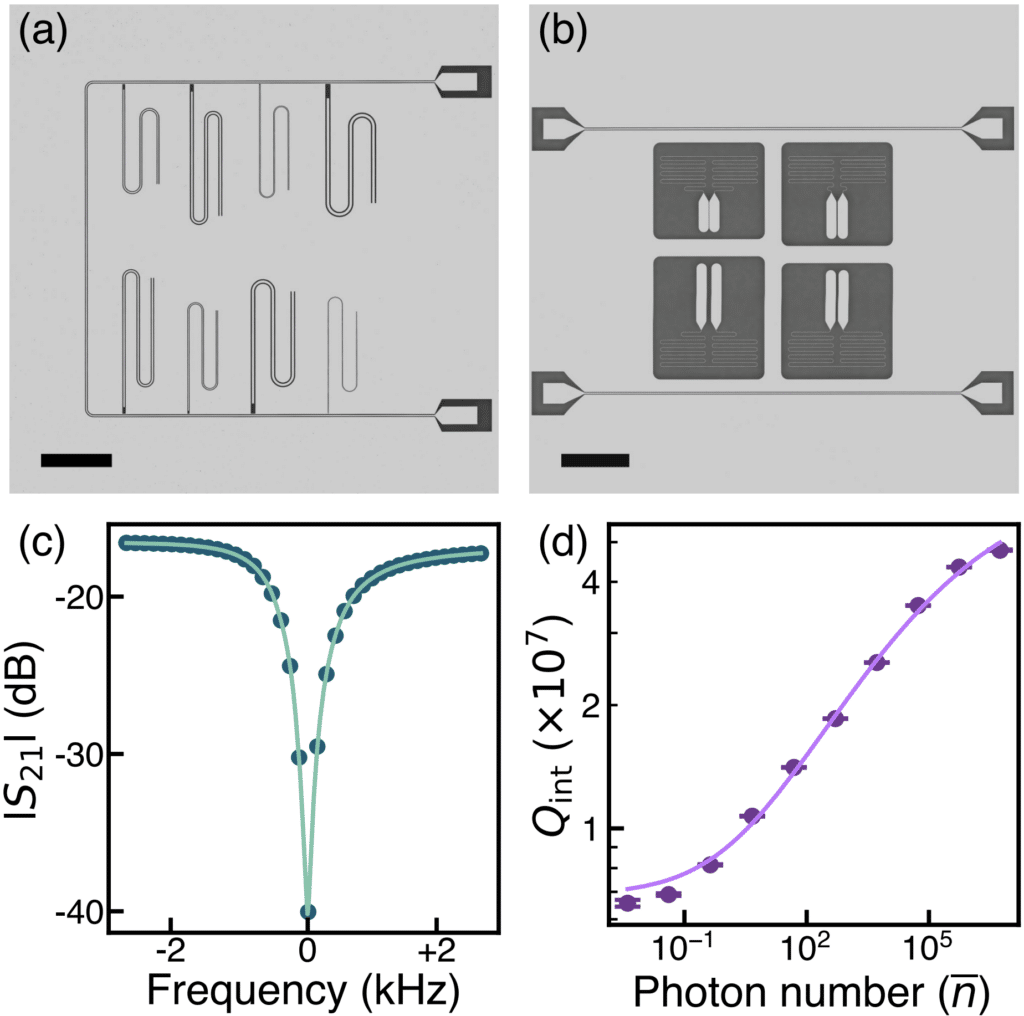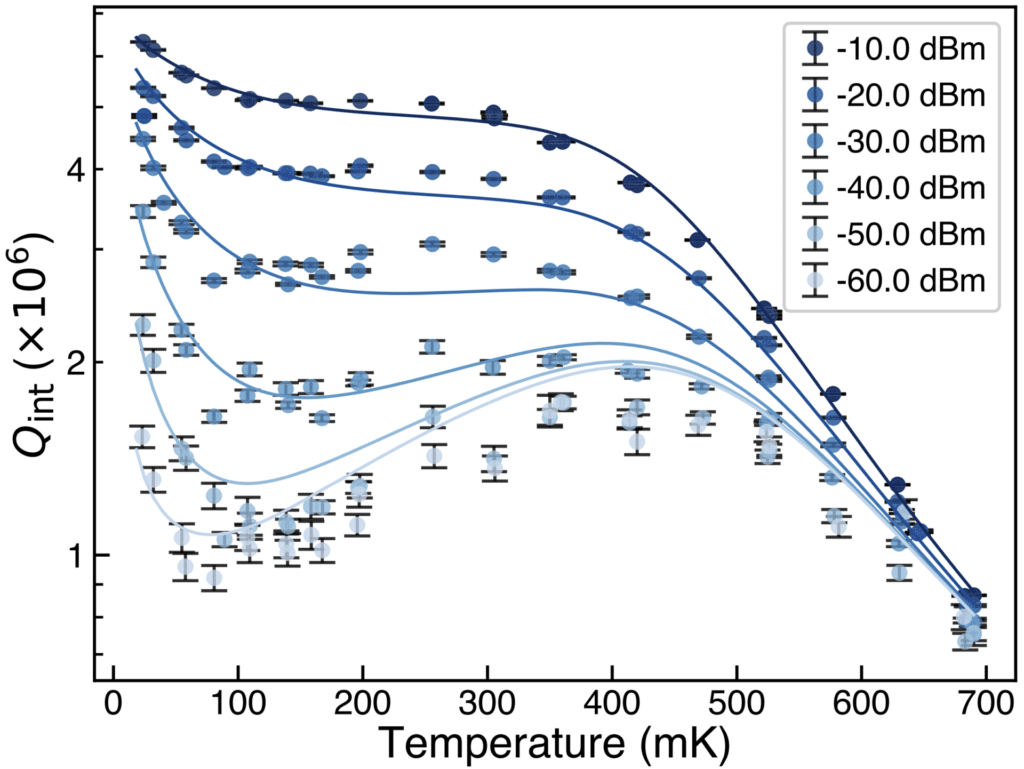Enhancing Quality Factors of Tantalum Superconducting Resonators with QCage
Superconducting qubits is one of the leading technological platforms in the race towards useful quantum computation but coherence times is limited by microwave dielectric loss. Much effort of the community has been placed into improving this aspect of this promising technology. Today, we explore a compelling research study by the Houck and de Leon Groups at Princeton University, recently published in Physical Review X [Physical Review X 13.4 (2023): 041005], that used our QCage chip carrier to explore the losses of tantalum superconducting resonators. Tantalum qubits promise lower microwave losses compared to niobium devices, and this recent paper suggests fabrication techniques to improve tantalum-qubits further than T1 coherence times of 0.3 ms demonstrated by the same group before [Nat. Commun. 12, 1779 (2021)].
Innovative Analysis Technique
The research team at Princeton delved deep into the sources of losses in tantalum superconducting resonators. Varying multiple parameters such as temperature, microwave input power, and resonator design, and through extensive measurements of quality factors, the researchers created a comprehensive understanding of loss sources. Some of the different resonator designs can be seen in Fig. 1(a) and 1(b). Their approach hinged on fitting internal quality factors Q_int, coupling losses, and resonance frequencies to the transmission spectrum. Such meticulous fitting, as illustrated in Fig. 1(c) and 2, sheds light on the nuanced internal quality factors (Qint) across temperatures and microwave powers, incorporating various loss contributors into their fit model.
The team’s ability to achieve remarkable high-power quality factors was instrumental. It permitted the differentiation of small loss contributions, enhancing the detail of their findings. Their conclusion was that state-of-the-art tantalum resonators are primarily limited by parasitic two-level-system (TLS) losses, rooted in oxide formation. Yet, the researchers offer first steps for post-fabrication, such as buffered oxide etch (BOE), to reduce surface oxide formation.

Fig. 1. “Measuring superconducting resonators. (a) Optical microscope image of a CPW resonator chip, consisting of eight resonators with varying pitch capacitively coupled to a single RF feedline. The scale bar represents 1 mm. (b) Optical microscope image of an LE resonator chip, consisting of four resonators with varying capacitor spacing inductively coupled to a single RF feedline. The scale bar represents 1 mm. (c) Transmission spectrum of a single resonator, centered about the resonance frequency f = 4.484501 GHz. The solid line indicates a fit to the data from which Qint, f, and the coupling losses are extracted. (d) Qint as a function of the applied microwave power, expressed in terms of the average intracavity photon number. The solid line indicates a fit to the data based on saturation of TLSs and an additional power-independent loss.” (Crowley et al.)

Fig. 2. “Parametrizing losses. Internal quality factor Qint as a function of applied microwave power and temperature for a characteristic resonator. The traces are well separated at low temperatures and then collapse together and fall exponentially at high temperatures. The characteristic shape of the curves is fit to a model incorporating TLS loss and equilibrium quasiparticles. Solid lines show the best fit to the dataset.” (Crowley et al.)
QCage at the Helm
One of the aspects highlighted in the study was the packaging of the devices under test. The research explored three different types of packaging: a conventional copper “puck and penny” assembly, Quantum Machine’s commercially available QCage.24, and a modified version of QCage.24 featuring an aluminum-flashed coating.
Remarkably, the findings shown in Fig. 3 suggest a notable impact of the package type to the internal quality factor Qint described as Q_other, a parameter representing additional losses of the resonator. QCage.24 didn’t just outperform the traditional “puck and penny” assembly but also showed a possibility for enhanced performance when used with an aluminum flashing.
QCage.24 didn’t just outperform the traditional “puck and penny” assembly but also showed a possibility for enhanced performance when used with an aluminum flashing.

Fig. 3. “ Dependence of extracted Q_other on SPR (surface participation rations), separated into devices packaged into the puck and penny assembly, the QCage.24 with bare copper surfaces, and the QCage.24 with aluminum flashed surfaces.” (Crowley et al.)
Driving Superior Outcomes
The researchers demonstrate that in some instances, Q_other is restricted by additional losses attributed to the used packaging solution, an element that is prominently evident in the puck and penny assembly but considerably mitigated with the employment of the QCage.24. The supreme values of Q_other discovered with the incorporation of aluminum flashing insinuates that in QCage.24, the electric field of the devices’ modes have substantial overlap with the packaging material, paving the way for improved outcomes by featuring a superconducting metal on the package’s nearest surface.
This research underscores the vital role played by meticulous device packaging like QCage.24, in achieving and refining measurements, especially in sensitive quantum experiments requiring ultra-low losses. It echoes our commitment at Quantum Machines: to accelerate quantum research and development to unrivaled speed through well-engineered solutions.

“QM’s chip packaging solutions are exquisite pieces of engineering that have enhanced our resonator Q-factors to as much as 200 million. It is clearly a very highly engineered product that I’m sure will be widely adopted in the field.”
– Kevin Crowley
PhD Student, Princeton University, Houck Lab
The Road Ahead
While the Houck/de Leon groups research at Princeton unfolds new chapters in understanding superconducting resonators, it also signals towards enhancing fabrication of highly coherent tantalum-qubits.
At Quantum Machines, our mission is to be the catalysts for quantum advancements – accelerating the realization of practical quantum computers, ensuring researchers and scientists are equipped with groundbreaking tools, like the QCage.24, to help quantum researchers succeed.